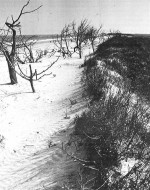Where the ocean meets the land in estuaries, a uniquely dynamic environment is found. In addition to oceanic storms and terrestrial disturbances, the rhythmic surging of the tides results in intertidal areas in which the biota face environmental stresses associated with both an aquatic and an aerial mode of existence. Typically extensive, highly productive marshlands border undisturbed estuaries.
The North Inlet LTER site, located near Georgetown, South Carolina, was the only marine system originally selected for inclusion as part of the LTER network. Most of the highlands surrounding this pristine estuarine system are owned by the Belle W. Baruch Foundation which has established these lands (17,500 acres) in perpetuity for research, teaching, and conservation. As common to all LTER sites certain broadly stated core questions are being answered using a long-term database. These questions deal with the patterns and dynamics of primary and secondary production and organic matter and inorganic nutrients.
In addition the frequency and influence of disturbance on system processes are being investigated. Nineteen faculty members, nine technicians, and numerous students study the various subcomponents of this system, including interactions with the Atlantic Ocean, an adjacent riverine system, and the uplands. The following are a few examples of substudies which contribute to understanding how the entire system responds to environmental changes on different temporal scales ranging from hours to decades.
Temporal variability in local sea level has an important effect on primary production in salt marshes because of changes in the duration and frequency of flooding within the vegetation region of the intertidal zone. Dr. James Morris has shown that annual primary production of Spartina alterniflora, the dominant plant in East Coast salt marches, varies by a factor of two and is highly correlated with the mean July-August sea level.
Sea level along the South Carolina coast oscillates seasonally with winter minima and summer maxima. However, there is considerable variability in the magnitude and timing of these oscillations. Mean sea level varies annually by as much as 15 cm during the peak of the growing season. In North Inlet marshes a decrease in mean sea level of this magnitude decreases the duration of flooding in the upper vegetated region of the intertidal zone (ca. 40- 70 cm elevation) by approximately 50%.
Changes in flooding frequency and duration have profound effects on sediment chemistry. In particular, sediment salinity increases In the high intertidal zone to a maximum near the mean high tide elevation. In this vicinity sediment salinity approaches 60°/oo, the lethal limit for alterniflora. and it varies according to flood duration, drainage, and evapotranspiration. Movements in this salinity maximum with changes in mean sea level regulate the productivity of alterniflora.
Interannual variations in primary production or sea level could have important consequences for secondary production. Morris, Dr. John M. Dean, and B. Kjerfve have found significant positive correlations between the residuals of mean sea level and the annual penaeid shrimp and menhaden harvests from the East and Gulf coasts. With shrimp there were no significant correlations when time lags of 1 to 4 years were included in the regression model. Since shrimp production would be expected to lag behind Spartina production if shrimp were food-limited, the absence of a lag suggests another mechanism. One possibility is that shrimp production may be responsive to sea level because of a habitat limitation. For example, sea level determines the extent and duration of flooding of salt marshes which affect feeding time and predator avoidance. Because of these and other possible mechanisms, including nutrient regeneration and transport, sea level variability has numerous implications for biological processes in the coastal zone. The Influence on estuaries of the long-term trend in rising sea-level is also being analyzed.
Dr. L. R. Gardner have demonstrated that the rapid turnover of sediments along creeks was greatly influenced by the burrowing activity of the conspicuous fiddler crabs.
Gardner’s work has implications for the spatial distribution and cycling of sulfur and carbon Isotopes. Gardner has developed a computer model for the effects of belowground production, aerobic and anaerobic decomposition, pyrlte oxidation, drainage, aeration and bioturbation on vertical profiles of organic matter, carbon isotopes, pyrite and dissolved oxygen in saltmarsh sediments.
Patterns of abundance and community composition of various species of animals inhabiting various habitats have been established: interannual temporal patterns are predictable but abundance is not. The meiofauna dataset of Dr. Bruce Coull, covering the longest time period of any dataset known In the world, provides the basis for experimental field and laboratory manipulations by Coull and Dr. Robert Feller in respect to such topics as predator-prey interactions.
Active intersite collaboration has involved various other LTER and non-LTER sites. In particular, under the leadership of Dr. Elizabeth Blood, analyses are underway to compare the relative impacts of the 1986 drought on the Coweeta LTER site and our site. Another project focuses on lead deposition in trees across the United States.
For information on the North Inlet LTER program contact Dr. F. John Vernberg, Baruch Institute, University of South Carolina, Columbia, SC 29208, or Dr. Dennis Allen, the site director, USC Marine Field Laboratory, P.O. Box 1630, Georgetown, SC 29442.

 Enlarge this image
Enlarge this image